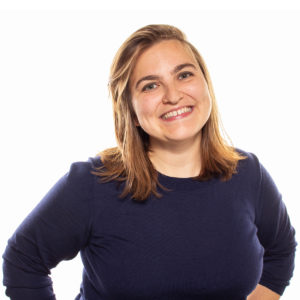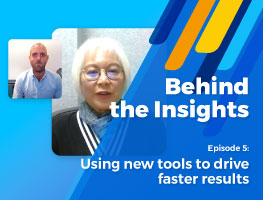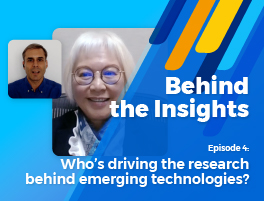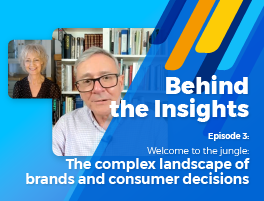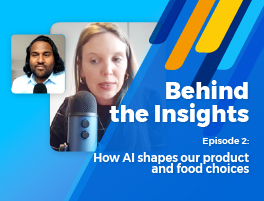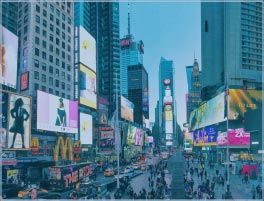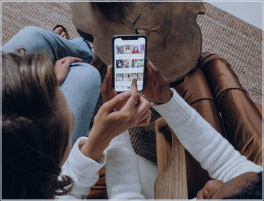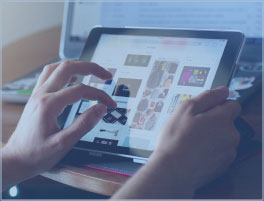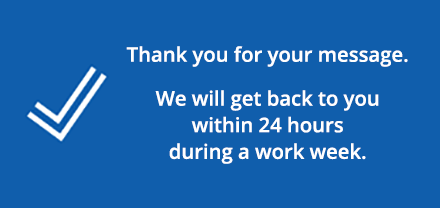Behind the Insights season 2 episode 1
Let’s get curious – Sparking engagement in the research industry
This is Behind the Insights, a vodcast series by MetrixLab. We talk to experts from all over the world to find out what’s really driving today’s hottest topics in insights.
In this episode, join MetrixLab’s SVP Group Lead, Michele McDonald, and Pierre Fabre’s Chief Data Officer, Sarah DaVanzo, as they have a curious conversation on fostering curiosity in brands.
Check it out and stay tuned for more episodes every month!
Or if you prefer, read the full transcript below.
Michele: Hi, Sarah.
Sarah: Hi.
Michele: I know that you know me already.
I’m Michele McDonald and I am a SVP Group Lead with MetrixLab, which means that I lead a team of client directors and also am a relationship manager with my own accounts. And that is actually how I got to know you in the first place, which is amazing. Do you want to just introduce yourself?
Sarah: Sure. Absolutely. Thanks. Yes, we work together. We’ll talk about that shortly. I have a 30 year career in data insights, analytics and foresight, strategic foresight. And I’m presently Vice President of Consumer Market Insights and Foresight at L’Oréal group of companies.
Fostering curiosity is a stepping stone to success
Michele: And I know, at least in your signature, you have a very cool title that you include.
Sarah: Sometimes. Sometimes I’m referred to as the chief curiosity officer. It happens to be a topic of curiosity as it relates to insight and foresight that I’ve been conducting extensive research on for over a decade, and I have a master’s degree focused in on this topic. So hopefully we’ll get to this in a little bit to talk about how curiosity connects to the world of market research and insights.
Michele: Well, then, actually, that is exactly why I reached out to you.
I have been involved in an initiative at MetrixLab where we’re working to articulate our purpose and evolve our positioning. And in that task force, one of the things that came very clear to us is that we as an organization have this challenger mentality.
And, you know, as we start talking about challenger mentality and what that means, you know, it’s this very consistent drive across our organization for constant improvement, innovation, growth. And we’re always kind of showing up with that entrepreneurial spirit and that permeates across each of the different divisions and markets.
And, you know, underpinning all of that is clearly curiosity.
Sarah: Sure.
Michele: But it’s something that we don’t really unpick. And that’s actually why I wanted to reach out to you, because I feel like you have obviously done quite a bit of research on curiosity and can help us to dimensionalize and articulate what curiosity actually means.
Sarah: Sure. I find that, you know, prior to L’Oreal, I was a chief cultural strategy officer at Sparks and Honey and I had other kinds of roles at agencies. So I have exposure working with well over 100 Fortune 500 companies and brands. And my exposure has been that, so many of them use curiosity as part of their corporate, if you will, tenets or corporate cultural manifesto.
And yet, you know, to be blunt, it was a lot of talk and not a lot of walk. And because, you know, if you’re going to treat curiosity as an asset, as a strategic tool, even as something that you’re going to engineer, right, one would put the mechanisms in organization to measure it through KPIs, to incentivize it, to have interventions, for example, that would help the employee base, you know, explore, because this is really a conversation around exploration and discovery.
You never unpack curiosity outside of the word, you know, exploration and discovery, right. And in addition, I’ve found that it’s, you know, to push people to be curious in the four modalities of curiosity that I understand it to be.
It’s often pushing people out of their comfort zone, and that requires one-on-one coaching. So I’ve found that to be quite effective, I also find setting up buddy systems where you have, like-with-like curiosity styles matched to help explore the world together, but then you purposely buddy them up to mix them up so that you have different, like wearing different hats or, you know, different Myers-Briggs personalities, where they’re working with each other to help stretch each other.
And that all requires, you know, trust. And an organization can’t be curious or have a curious employee base, unless there’s a lot of trust in that space. So sometimes that gets in the way of the challenges.
Michele: And I think it’s trust and I know for us it’s empowerment. So that everyone feels safe to take a risk and to speak up and to share their thoughts, share their ideas. And that is, I think, critical, certainly within our organization, as we look to grow.
Sarah: Sure, sure, and I think, you know, if an organization is really serious about doubling down, on elevating or what I would call amplifying the curiosity of the culture and the organization, there’s two things. It’s not only amplifying the curiosity, it’s also tactics to also apply it to the day to day.
You know, whether it’s, you know, I don’t know. I just want to put it out there that, you know, curious people build curious brands, or curious businesses. So, curious brands and curious businesses is the new form of engagement.
So, if your consumer or user or target human is not curious about the brand or your business, you obviously can see that through search and you can see that through the types of engagement. They’re not going to try the product.
Michele: So we can’t just speak to the consumers anymore, they have to seek us out.
Sarah: Right. And there has to be stickiness. And it’s an ongoing relationship of continuously being curious to them, so that they’re constantly interested in what you have to say, what you’re doing, what your news is, what your products are, how you operate. And so this idea of, like, I like to call it a “curiosity quotient” or a “curiosity index” for brand health is a real thing, you know, that we measure engagement in many sophisticated ways today, and that’s one of the metrics. But truly from experience, it’s curious people that build those brands. And so that’s the application to business.
Michele: Well, and for us as an agency working with all these different brands, it’s wild to see how corporations are trying to navigate those waters, because the bigger you are, the more risk there is to being curious and being open to change. And so, you know, we keep seeing startups that come on the scene and disrupt and, you know, make a real difference and the big guys try to just buy them up because that’s the safer way to go.
And I think for us in our conversations with brands, it’s really interesting because, you know, they’re not always working, especially within insights, right? You’re not always working with an agency that is going to call you out or say, “That direction is not going to really help you because it’s not going to engage,” or “It’s not going to stretch” or “It’s not going to disrupt”. And, you know, so tying it back to us, right, that’s what we do. We push the envelope, so we push ourselves, but then we push our partners. And I think that that actually is part of why MetrixLab has carved this niche for ourselves.
We’re not just a tech platform and we’re not the big corporation, but, you know, we’re still human, and we have a point of view. We’re real people.
How do we navigate curiosity
Sarah: Exactly. Well, I think, you know, when we talk about how to apply curiosity, the framework that I would sort of share with you, because it’s not necessarily the obvious approach to curiosity, but if you look at animals, animal behavior of curiosity, exploration, discovery, insight, right, or curiosity, exploration, discovery, we don’t know if the animal has insight, but the point is, is that human behavior follows a similar pattern and there are four styles or behaviors of curiousness.
The first is the most obvious, which is intellectual curiosity. You know, exploring in your mind, you know, asking questions and so forth. But there are three other modalities that people don’t tend to think about, which are manifestations of curiosity, exploration and discovery.
First of all, it’s visual curiosity. Just looking and being really good lookers, you know, that’s observation. And we use that all the time in our consumer research, you know, either with you behind the glass or in front of the glass or out in the wild, but being deep observers and looking for patterns, I mean, think about, you know, being someone on the beach 300 years ago and observing and seeing some ships on the horizon coming toward you and thinking, okay, what’s happening here? That’s a new thing. How do we react? And going back and rallying, you know, your family.
The point is, is that, that observation helps with survival, right?
Then a third aspect of, or modality of, curiosity is what I call “feeling”. You know, it’s the sensory. Some people explore viscerally, rollercoaster rides, food, putting themselves in thrilling environments, bungee jumping. You know, there are lots of visceral – ASMR, exploring through aural and oral, right. And so through the senses and through the feelings and emotions, that’s a modality that some are comfortable with and others are not comfortable. For example, I struggle with that modality so I know I push myself specifically because in my profile, like my Myers-Briggs-like curiosity profile, that’s the weakest link.
And then there’s the fourth, which I know when I say it, you’re all going to go, “Oh, yeah, I know that.” But we never tend to think of this as a modality of curiosity, or exploration and discovery, which is basically what I call “doing”. It’s experimentation, it’s poking, it’s physically going. That’s travel, putting your body into a physical environment with new people and new experiences and making and building with the intention of experimentation.
So, see, feel, think, do. Four modalities you see, feel, think and do. But then interestingly within that, there are also four schema, ways that are also part of your unique profile. So one is, is it trait or is it state?
So in other words, is this, your natural – is it nature versus nurture, right? Is this your natural state of curiosity, or did your boss make you, did your client ask you, to research a topic? So the way you’re going to attack that topic is going to be very different if it’s trait versus state. Because of the level of interest, the engagement.
We also have generalist vs specialist – T-shaped. You know, I have lots of hobbies and passionately curious about, right. But and when I, you know, used to go do research and like the Maker Fair, for example, we found lots of people were very specifically curious about 3D printing or Arduino, you know, Raspberry Pi or coding or gaming and lack that general curiosity around, you know, just the world in general. Then you have the idea here is the external and internal motivations. You know, are you getting satisfaction from this or am I getting rewarded for my curiosity?
And then finally, what I would like to say is that there’s an intensity level. So some are very curious at a low-grade level. Like, you know, I try to do that. I’m trying to introduce curiosity every day in my life. It’s very hard, especially the day I had yesterday. I was at the computer all day, doing number crunching and whatnot. But low grade, which is one style, which is kind of a slow burn. And then there are those that have burst on the weekends and do different kinds of intensity.
So there’s an intensity level, too, that we can measure. Just by having a conversation about how your week went would reveal things about your style, which will be unique, and pairing you up to someone who might have a different cadence, who might have different motivations, who might be a specialist, whereas you’re a generalist or might be you’re innate in someone else’s state that could be very, very helpful to expand your satisfaction in your exploration discovery.
And I just want to say, sorry to be so long-winded, but the research I had conducted with 177 insights professionals from around the world, it’s on my website, InsightScience.com. And that was a giant piece of research on how to be more insightful. The number one trait of our industry was curiosity. No surprise. But 70% believe that curious people are more insightful people. And over 60% believe that both curiosity and insightfulness can be taught.
So it’s plastic. And if we’re saying that our job is insights, and to be insightful, to see things, to discover, then this is directly connected to that process of analytics, insights and so forth. And so, you know, the idea here is that let’s go to the root of it, and see what we can do to build the curiosity muscles that will then translate into insightfulness and better work. Right?
How curiosity can make a difference in innovation
Michele: Absolutely. And I’m glad that you pivoted, actually, because I think of our teams and, you know, how I’ve always tried to operate. I always think in terms of lifelong learning. And, you know, you don’t just show up and do the same thing and rely on what you did in the past. You learn new – whether it’s methodologies, techniques – new understanding of the world around you, and in the way that you engage is different.
So I’ve always tried to foster that in my teams. And in my family, right, in my home life as well. But inherent as part of that is curiosity. And it’s interesting to start thinking in terms of mixing and matching the different modalities of curiosity to, you know, when your ideating on something to get to a more creative outcome and then, you know, again tying it to, you know, brands and our clients like as we recruit into qual workshops or as we, you know, kick into innovative product, there’s so much that we can do to get us to a better place.
Sarah: So yeah, I can just give you a real anecdote on this, is that some of the research I’ve been doing is tracking on normal innovation processes or ideation or even insights workshop processes. And by and large, if you really engineer the curiosity and you know, and curate the groups and push it and, you know use exercises in that respect that it’s, you know, at all the four modalities of seeing, feeling, thinking and doing and exploring, you can truncate something that would take two days to a morning. So it’s an exponential like a) you’re getting to better output sooner, which can save money, okay. So that’s at the bottom line, a better output. And I do think that’s something you said really importantly, lifelong learning. But think of it differently. This is about reframing, we’re going to be in a curious conversation right now. It’s not just like lifelong learning, it’s lifelong doing, it’s lifelong seeing, it’s lifelong feeling, it’s lifelong all of those modalities. And so now it’s thinking about how it’s not just “Be Curious,” the bumper sticker that we see on all the cars.
It’s do curious. It’s see curious. It’s feel curious. And that just changes the perspective because we can really, especially our industry, get in the myopic, you know, the myopia of just thinking that intellectual curiosity and parsing data on my computer and sitting is what it’s about.
And, you know, if you choose to, you know, forest bathe or walk in the wind, or explore, go to some events that might put you in a little bit more uncomfortable place. You might actually unlock new kind of connections on the work that you’re doing. And I’ve found that to be the case, that it creates new synapses and new discovery happens.
Michele: And it’s so critical. Like, you know, I think we had talked earlier about this crossroads that we’re facing, right, in the industry.
And it is a critical moment and it’s really an exciting moment. But it’s also like a heartbreaking moment when I see people leaving our industry because it’s not dynamic or because we’re not embracing. And so I think it’s, you know, a passion point for me is to push to be the proactive, be the thinkers who are driving actual action and material action as opposed to the, you know, traditional researchers of the glasses and just reacting to sort of looking in the rearview mirror.
Michele: I am so appreciative of speaking with you. I’ve been so curious to have had this conversation for such a long time, and I just I adore working with you, I appreciate the partnership. And then especially for today, I greatly appreciate this conversation. Thank you.
Sarah: Thank you, Michele, likewise. This has been, we’ve had great engagements. So live curiously, right? That’s my signoff. Live curiously. Okay. Thank you. Have a good day.
Michele: Thank you.
Sarah: Bye bye.
